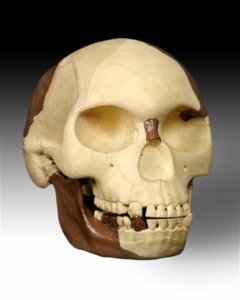
Piltdown Man Skull
In 1908, a worker at a gravel pit in Piltdown, England, found pieces of a skull. The discovery attracted the attention of a collector named Charles Dawson, and paleontologist Arthur Smith Woodward. These men found additional pieces of the skull at the site, as well as a jawbone apparently belonging to the same creature. The creature seemed to have a brain around two thirds the size of a human’s, while its jaw was similar to that of a chimpanzee’s. It was called “Piltdown Man.”
Scientists were excited by this discovery. The find suggested that this might be an intermediate step in the evolution between apes and humans – possibly a “missing link.” It fitted in with current theories about evolution. British scientists were pleased to make such an important find in England.

Franz Weidenreich
Not everyone was convinced of Piltdown Man’s authenticity. Some questioned whether the jaw belonged with the skull. Franz Weidenreich determined that Piltdown Man was composed of a modern human skull and the jaw of an orangutan. His findings, published in 1923, were ignored for thirty years.
Unfortunately, Weidenreich was right. Someone had given a human skull the jawbone of an orangutan. They’d filed down the teeth to make them seem more human, and stained the bones to make them appear fossilized. No one knows who did it. Suspects included Dawson, along with such notables as Pierre Teilhard de Chardin and Sir Arthur Conan Doyle.
It wasn’t until 1953 that modern tests showed conclusively that the bones were modern. Piltdown Man was a fake.
This hoax is often used to bolster criticisms of science. Scientists were fooled by the fraud. Clearly scientists don’t know everything. If they base their beliefs on fake fossils, how can we rely on what they say?
Scientists don’t know everything. They make mistakes, including falling for hoaxes. However, they don’t base their beliefs on fakes.
Because Piltdown Man was unique, notions based on it were considered highly speculative. Other hominid fossils contradicted what Piltdown Man seemed to show. Hypotheses based on Piltdown Man had no support from other sources. The hoax had little impact on theories of evolution.
It was the scientists themselves who discovered the fraud. By repeatedly examining and testing the fossil, they eventually recognized that this was a modern forgery. As new tests become available, old data are reexamined to see whether they pass the tests – and to check whether the tests themselves are reliable.
The strength of science is not that it is infallible. Its strength is that it seeks to recognize and correct its mistakes. Piltdown Man is an example of this process.
